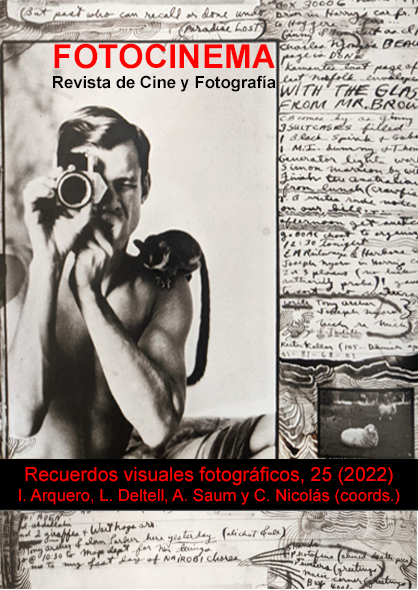Notes on photography and memory from the rereading of Regarding the Pain of Others by Susan Sontag
DOI:
https://doi.org/10.24310/Fotocinema.2022.vi25.14482Keywords:
Photography, Memory, Violence, Power, Image, CommunicationAbstract
Knowing the effect of photography on memory has been a topic of recurring interest. Since its invention, photography has been associated with memory and the desire to capture time, lofty aspirations that have been transformed by its uses and overcrowding. In her book Regarding the Pain of Others (2003), Susan Sontag examines photography in the context of war, pain, and compassion, its links to the past, and its ability to shake consciences and public opinion. In this article we will review the validity of some of her approaches, attending the intersections of photography with three key concepts: memory, power and violence. The possibilities of circulation of photography, the modes of reception and production, as well as the interests to position some images and discard others, to remember some and forget others, open ethical discussions and questions that acquire relevance in the current complex scenario.
Downloads
Metrics
References
Barthes, R. (1989). La cámara lúcida. Notas sobre la fotografía. Paidós Comunicación.
Borges, J. L. (1969). Elogio de la sombra. Ediciones Neperus.
Burke, P. (2005). Visto y no visto. El uso de la imagen como documento histórico. Crítica.
Didi-Huberman, G. (2012). Arde la imagen. Ediciones Ve S.A. de e.v.
Flusser, V. (1999). Hacia una filosofía de la imagen. Editorial Trillas.
Fontcuberta, J. (2011, 11 de mayo). Por un manifiesto posfotográfico. La Vanguardia. Recuperado de https://www.lavanguardia.com/cultura/20110511/54152218372/por-un-manifiesto-posfotografico.html
Mitchell, W. J. T. (2017). ¿Qué quieren las imágenes? Sans Soleil Ediciones.
Montiel, T. (2016). La fotografía policial en el siglo XIX. El sistema Bertillon. ArthyHum (21), 148-159.
Pantoja, A. (2007). La imagen como escritura. El discurso visual para la historia. Norba Revista de Historia, Universidad de Extremadura (20), 185-208.
Perceval, J. (2017). El terror y el terrorismo. Cómo ha gestionado la humanidad sus miedos. Ediciones Cátedra.
Pereiro, X. (2005). Apuntes de antropología y memoria. Revista O Fiadeiro – El Filandar (15). Recuperado de https://galiciaencantada.com/archivos/docs/528_Pereiro,%20X.ANTROPOLOGIA%20Y%20MEM%C3%93RIA.pdf
Sontag, S. (2003). Ante el dolor de los dema?s. Santillana Ediciones Generales.
Soulages, F. (2015). Desde una este?tica de la fotografi?a hacia una este?tica de la imagen. Universo Fotogra?fico (4), 114-128.
Vallejo, I. (2019). El infinito en un junco. La invención de los libros en el mundo antiguo. Ediciones Siruela.
Downloads
Published
How to Cite
Issue
Section
License
All contents published in Fotocinema Revista científica de cine y fotografía are protected under the Creative Commons Attribution-NonCommercial-ShareAlike 4.0 International (CC BY-NC-SA 4.0) license. All about this license is available in the following link: <http://creativecommons.org/licenses/by-nc-sa/4.0>
Users can copy, use, redistribute, share and exhibit publicly as long as:
- The original source and authorship of the material are cited (Journal, Publisher and URL of the work).
- It is not used for comercial purposes.
- The existence of the license and its especifications are mentioned.
There are two sets of authors’ rights: moral and property rights. Moral rights are perpetual prerogatives, unrenounceable, not-transferable, unalienable, imprescriptible and inembargable. According to authors’ rights legislation, Fotocinema. Revista científica de cine y fotografía recognizes and respects authors moral rights, as well as the ownership of property rights, which will be transferred to University of Malaga in open access. The property rights are referred to the benefits that are gained by the use or the dissemination of works. Fotocinema. Revista científica de cine y fotografía is published in an open access form and it is exclusively licenced by any means for doing or authorising distribution, dissemination, reproduction, , adaptation, translation or arrangement of works.
Authors are responsable for obtaining the necessary permission to use copyrighted images.













13.png)




